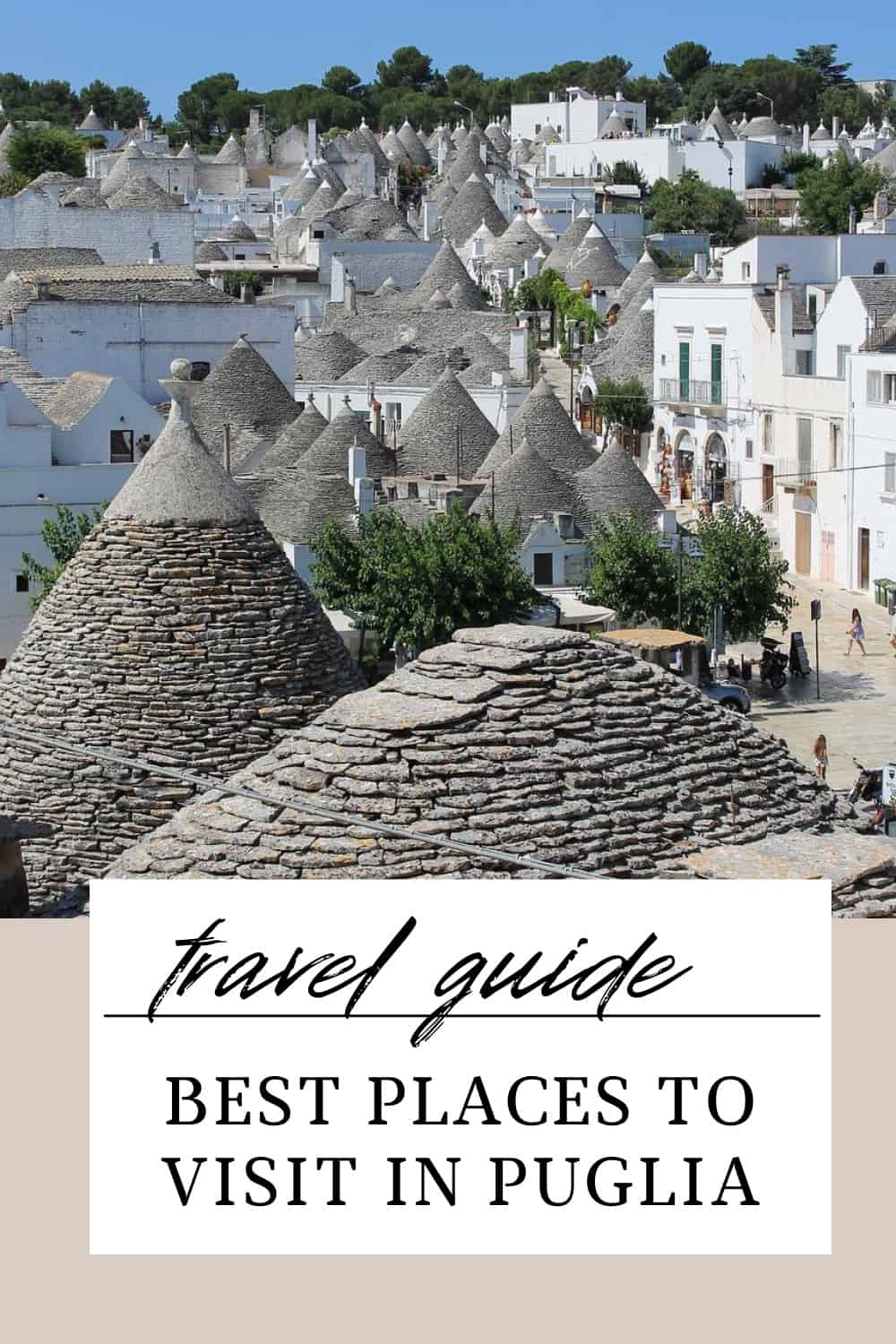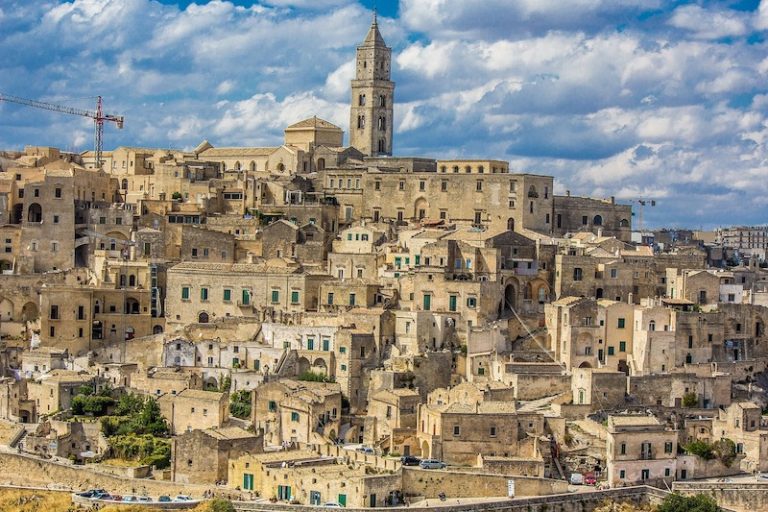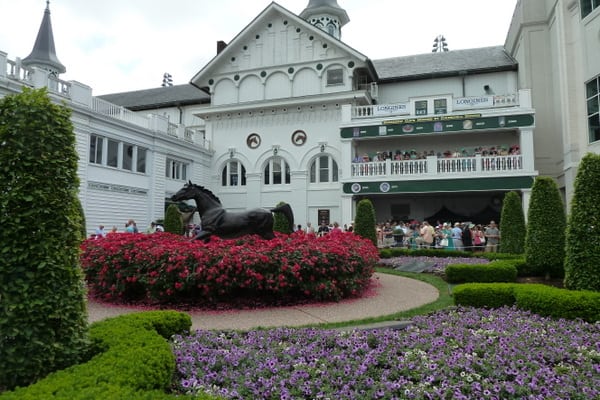14 Best Places To Visit in Puglia
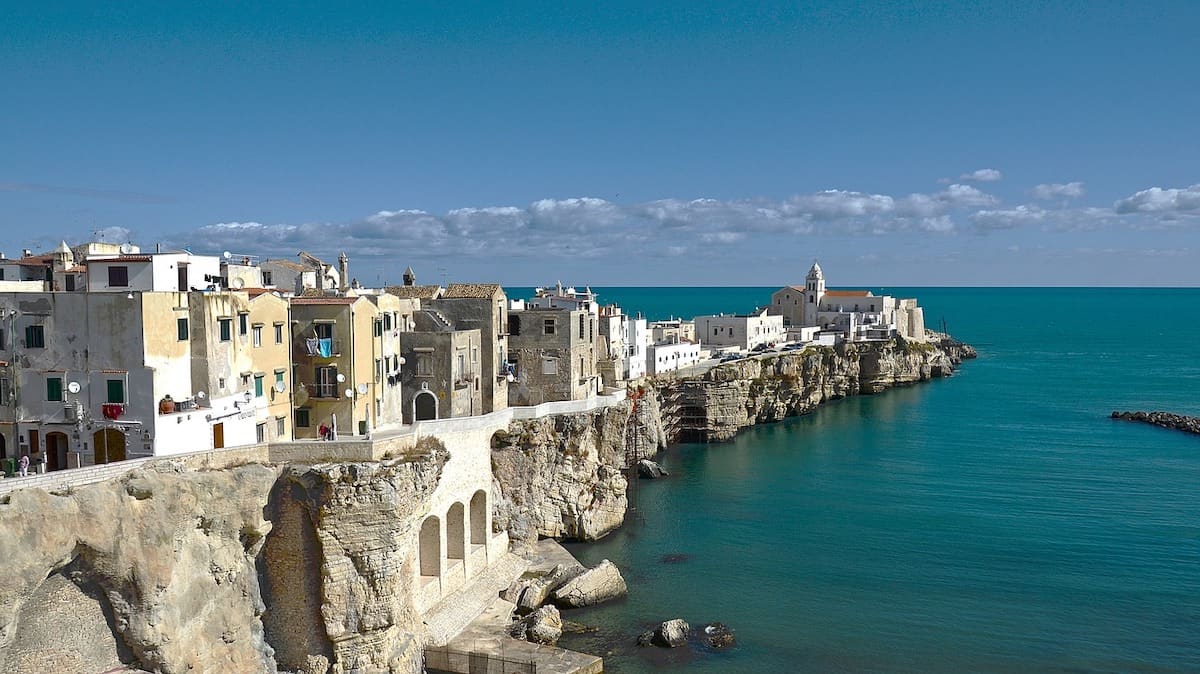
Need advice on the best places to visit in Puglia?
We are delighted to share this sponsored post written by Paolo Margliulo, the Go Ask A Local guru for all things Puglia, who offers some insider tips.

Now based in Matera, Paolo has spent his entire life living, learning, and exploring this amazing region. With more than 15 years of experience as a guide and trip planning consultant, he specializes in food, wine, history, culture, and art.
We’ve visited six of Paolo’s favorite 14 best places to visit in Puglia and can’t wait to return to meet Paolo, dig deeper, and take advantage of his local, insider expertise.
We are sure you’ll want to take this list (or Paolo)on your next trip!
Puglia: No longer a hidden gem

Located in Southern Italy in the heel of the boot, Puglia was largely undiscovered until the last 15 years or so. While it is best known for its stunning coastline, baroque architecture, and bucolic villages, it’s also a place of ancient traditions carried on today, welcoming people, and of course the cibo – our food, distinct from anything else you’ll find in Italy.
When I started my university studies in 1996, my family was seriously concerned about my decision to study Preservazione dei beni culturali (preservation of the cultural heritage) which basically means history and art history. I was interested in promoting the area, but almost nobody was interested in coming to Puglia! Not even Italians knew anything about our traditions and culture.
The very few tourists who did make it here came only in the summertime to enjoy the seaside. Lecce had no hotels, getting there by plane was expensive end extremely complicated, nobody was able to speak English, and many of our historical centers were still totally abandoned.
It is incredible to see how much has changed. We are cleaning up and restoring countless cities and towns, and the services we’re able to offer rival many much more established regions. Everything from hotels and nice restaurants to infrastructure and tour guides has improved dramatically. Even our wine production has grown so much that a tiny region like Puglia now produces almost half as much wine as the entirety of the United States.
For those of us born or who have been living here, it is almost unbelievable to see how quickly things have changed and how many people now come here to enjoy our region. That said, there is still so much that remains undiscovered. Although Puglia as a region is no longer a “hidden gem,” with a little effort and by getting away from the major touristic centers you can find countless small villages and hamlets that are practically unchanged by tourism.
While everyone loves local secrets and places where they will barely see another tourist, at the same time visitors appreciate good restaurants, nice cafes, menus in English, and being able to communicate with people. The list that I’ve curated involves some must-sees and some tradeoffs. A few of the places I mention below have been changed by tourism but their charm is still uncontaminated and authentic. This means they also remain a bit rustic and wild.
It is extremely hard to name the best places to visit in Puglia because there are so many wonderful towns and villages. But ma proviamoci, let’s try!
Best Places to Visit in Puglia
Lecce

In the southern part of Puglia, in a peninsula called Salento, you’ll find a real gem. Simply walking around and admiring its beautiful center is enough to recommend a visit, but what makes Lecce such a charming place is the atmosphere and its people.
Lecce has only 100,000 inhabitants and that means that you won’t feel the stress and the traffic of a bigger place. The city’s baroque and rococo architecture, pedestrianized center, elegant avenues, and countless squares make it a wonderful city to visit leisurely.
Local people love to stroll around and sit outdoors in any of the city’s myriad cafes, pastry shops, gelaterias, or open-air bistros. In the early evening, you might feel as if every resident is outside somewhere having a pre-dinner Aperol Spritz. You should too! If you fancy a casual, but very informative tasting of Puglia wines, a visit to local sommelier Enrico’s stylish enoteca Crianza is a must.
Be sure to catch a glimpse of the lovely historical gates to the city, Porta Rudiae, Porta San Biaggio, and Porta Napoli as well as the beautifully renovated Basilica di Santa Croce and the stunning Duomo.
Lecce also makes an ideal base from which to visit the nearby coastal towns of Otranto and Gallipoli. If you have a car, the best way to visit both is a drive from Lecce through Gallipoli before hitting the coast road SP 308 at Santa Maria di Leuca, where the Ionian and Adriatic seas meet. The route hugs the cliffs for 60 km and affords sea views the entire way to Otranto. It is one of Italy’s most beautiful drives.
Otranto

Otranto is a historic port in the Salento region that is most famously the site of a massacre of 800 Christian martyrs at the hands of Ottoman invaders during the 15th century.
Today, it’s a lovely little town with a festive summer atmosphere, good beaches, and a gorgeous Cathedral housing a marvelous floor mosaic from the 1100s. Don’t make the same mistake as most – note that the church only opens after 3 pm so be sure to visit in the afternoon.
If you find yourself here at lunchtime, a good option is L’altro baffo where seafood, no surprise, is the specialty. If you’re willing to trade culinary excellence for a sea view, I Villani D’Aragona sits directly on the water.
Many of the beaches in this part of Salento are rocky or paved jetties, but just a few minutes from Otranto you have sandy Torre dell’Orso beach. Relaxing in the sand is the perfect way to unwind after a day of exploring. And for anyone traveling with children, there are lots of options for watersport activities and rentals right on the beach.
Matera
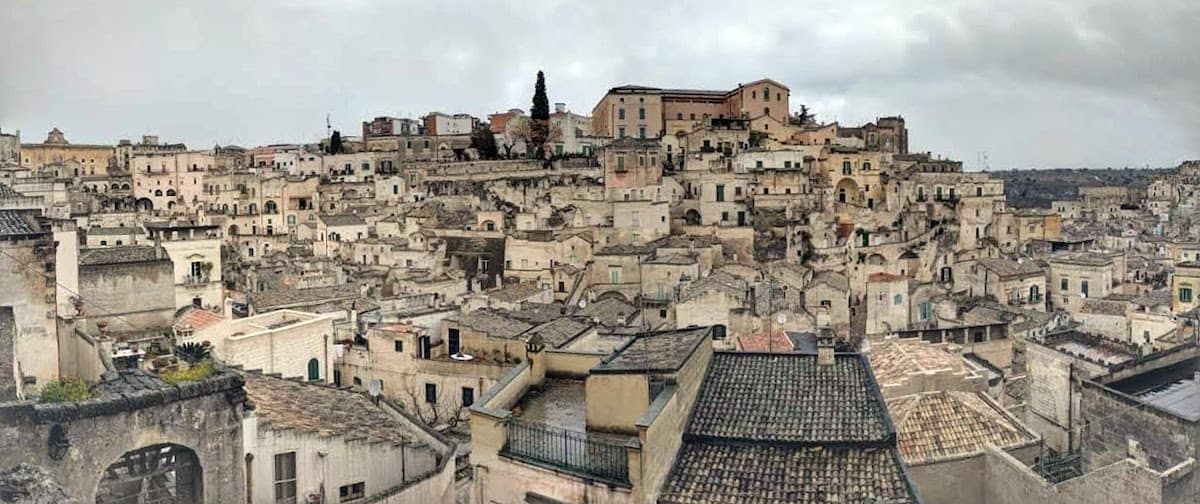
While Matera isn’t technically in Puglia, it is located only a few miles over the border into neighboring Basilicata and every visit to Puglia should include a stop here.
Driving to Matera you will see the landscape change and move from the sea to olive orchards, then to wide extensions of durum wheat fields before suddenly, like a slash in the earth, a majestic canyon appears with a city on its edge.
Matera is an experience; a jump back into time with thousands of years of history made by people that managed to carve the rocky side of this canyon into nearly 5,000 caves used for living well into the 1950s.
If you are more of a slow traveler (as opposed to a tourist) you won’t miss the opportunity to live the experience at its best by choosing one of the many cave hotels as your base. While in town, you’ll have the chance to discover Matera’s stunning treasures, as well as the canyon and the practically untouched rocky dwellings, cut into its side.
The cave dwellings, or Sassi as we call them, are Matera’s main draw. However, the whole city is magical and you will love simply meandering through its streets. Matera is full of staircases, alleyways, lovely churches, and lookout points, and wandering around with no particular direction is one of its biggest charms. At dawn and dusk, the light cast over the Sassi and the deep ravine feel like a fairytale.
The most famous of Matera’s architectural wonders are two fresco-adorned rupestrian churches, Chiesa di Santa Maria di Idris and Chiesa di Santa Lucia alla Malve from the 12th and 13th centuries. They are unmistakable from anywhere in town and should be one of your first stops. However, to avoid the crowds and have a more unique experience, I recommend a visit to the Cripta del Peccato Originale. The church, from the 8th century, was carved out of the side of a cliff overlooking a gulley and has stunning frescoes.
Cisternino

The fertile core of Puglia is a valley called the Valle D’Itria where the soil is deep red and the little fields are enclosed by perfectly stacked stone walls. It’s the land of the Trulli, the canonical stone roofed houses most well-known in nearby Alberobello.
This is definitely the most famous part of Puglia with Alberobello the star attraction. However, while Alberobello is a cute town and worth a short visit, it has become extremely touristy over the years so I wouldn’t recommend staying for long. The countryside between Alberobello and Ostuni has countless Trulli houses dotting the hillsides and a more authentic environment.
Instead of Alberobello, plan to spend more time in Cisternino along with Ostuni, Martina Franca, and Locorotondo. Each of these villages has its own charm, but Cisternino, where the typical whitewashed walls are enhanced by elegant rococo decorations, stands out.
Cisternino’s centro storico was elected one of the most charming borghi or neighborhoods of Italy. While here, be sure to visit the Chiesa Matrice and Torre Civica before a walk down Via Basilioni to Vittorio Emanuele square.
The town is famous for butcher shops which offer the option of purchasing your meat and having it cooked on the spot in a fornello, a special wood-fired oven that uses a technique borrowed from the Arabs. For anyone feeling daring, gnumnarid is extremely typical and is lung, heart, or liver usually of a goat or sheep that is wrapped with the intestine and then grilled. It’s an adventure! A good and traditional place to try these local specialties is Bére Vecchia.
Ostuni

Whitewashed Ostuni, rising out of a plain and perched atop a hill overlooking the Adriatic, is a mesmerizing sight. Also known as the white city, it’s just a few miles from Cisternino, but the land changes dramatically between them. Rolling hills give way to a flat plain as you approach the sea. Visible from all directions and surrounded by thousand-year-old olive groves, Ostuni is unmissable.
The city is often used as a base to explore the entire peninsula because of its proximity to both the sea and many lovely villages, as well as its strategic location halfway between the two major airports. Ostuni was built in the Middle Ages and has become very trendy due to its whitewashed buildings with colorful green and blue doors.
At the very top of the hill in the old quarter, you’ll find an exquisitely ornate cathedral with Romanesque and Gothic decorations. As you wind your way up to the Cathedral from Piazza della Libertá, be sure to make time to wander down the many alleyways that connect the main street. One of the best gelatos that you’ll find in Puglia is right in the centro storico at Cremeria La Scala where everything is produced in-house with fresh local ingredients.
Monopoli

No trip to Puglia would be complete without a few days relaxing by the seaside. You should plan to spend a few days around Monopoli which is in the Savelletri area. This part of Puglia is famous for sandy beaches, silky waters, and masseria-style accommodation, which are fortified farmhouses from the 1800s that have been stylishly renovated and turned into hotels.
You’ll find that most are mid-range or luxury and they often have fabulous restaurants and the option of half-board bookings where your dinner is included in the price. Many have their own little gardens and farms and the food is often produced on-site. I would recommend that you stay outside of town so that you can enjoy the rural environment and easy access to great beaches.
Monopoli was traditionally a fishing village and is now a nice-sized town with a lively atmosphere. It has a cute little port, a lovely promenade, and a pleasant center. The Cathedral is beautiful and you can also visit the Grotto Churches which house exquisite frescoes. It’s a good place for anyone who wants a little bit of nightlife without being overly party-oriented.
For dining, fresh seafood is always your best option and the ricci (sea urchins) are a particular delicacy when in season. If you’re happy with something very casual (think plastic tables in the sand right on the water), make sure to visit Il Principe del Mare where the fishermen will clean the urchin in front of you and serve you a heaping portion at a price you won’t believe.
Polignano a Mare

Polignano juts into the sea on a rocky promontory above a bay whose cliffs are full of caves. There are no major sites in town, but it’s charming and atmospheric. The houses are built directly into the cliff face and look as if they’re about to fall into the sea.
Every year Red Bull sponsors a cliff diving contest where you will find residents and visitors alike diving from walls, out of house windows, and off of bridges. If you’re crazy enough you join them -don’t worry it’s only 100 feet!
If you want to go for a boat ride, there are many agencies offering everything from speedboats to catamarans and short tours to overnight sailing trips. You should also stop at a caffè for a Speciale which is an espresso with cream and lemon zest. It is unique to Polignano and you won’t find it anywhere else.
While you’re in the area, just outside of town a great spot for seafood dinner is La Locanda di Felisiano. It can be a bit hard to find, but the food is excellent, the price fair, and the atmosphere welcoming and festive. You can order shared small plates of seafood to start and anything from an unusual pasta with pesto and mussels to whole grilled fish for mains. The owner, Felice, will be able to recommend fabulous local wines to pair with your meal. It’s the perfect way to end a day in Polignano.
Nardó

The largest village in the province of Lecce, Nardó has a lot to offer. While it’s still relatively off the map, now is the time to visit. Over the last ten years, the local government has started to restore and promote the old town and locals have taken note; people are moving in and new shops, restaurants, and cafes are opening up. It’s definitely coming back to life!
The main square is one of the best in the entire province and you’ll see a rococo touch everywhere. The church of San Domenico offers you one of the best examples of the local baroque style. The gorgeous palazzo which now houses City Hall is one of many other lovely buildings and churches; it was once the noble residence of a local lord. Inside you’ll find beautiful decorations and a gorgeous garden surrounding it.
Near Nardó there is a lovely borgo called La Cenate along the road that leads to the sea. It is a shady and cool area full of beautiful villas dating to the end of the 1800s. Continuing along the same road, you’ll arrive at a charming village called Santa Caterina which is the perfect place to stop for a swim and a gelato.
Galatina

North of Nardó, you’ll find the town of Galatina. The town’s centro storico is tranquil and relatively undiscovered. The palazzi still reveal their faded glory and the lichen and moss growing on them gives you a sense of their history.
There is already a bit of tourism in Galatina with the main draw being the church of Santa Caterina which houses stunning frescoes painted at the end of the 1300s. Arriving in the old town you will eventually reach another very popular place that’s hard to miss as you will usually find people queuing outside. It is a pastry shop called Ascalone, don’t forget the name. It is the oldest pastry shop in the area… opened in 1745!
Entering this tiny little boutique is like traveling back in time and the pastries they make are strongly linked to the local traditions. Definitely do not miss their pasticciotto, a local short bread pastry filled with custard. Another treat is their cookies made with almond paste.
Galatina is also the capital of a local dance called la pizzica. Tradition claims that it was invented to cure people that believed they had been bitten by tarantulas. Exiting the pastry shop to your left and walking for less than 2 minutes you’ll enter a wide square that historically was used by people to dance the pizzica in a sort of communal exorcism intended to free people from the evil possession of this imaginary spider. A documentary was filmed in 1962 when an Italian anthropologist came here to study this phenomenon.
Oria

Leaving the province of Lecce and traveling further north into that of Brindisi, you move from the extremely flat Salento peninsula into a hilly area dotted with interesting little villages. One of them, probably the least known in the province, but extremely charming nonetheless, is Oria.
The village sits atop a hill and is still genuinely authentic; every person you meet will look at you like an alien and they will be curious, in a friendly way, to know why in the world you are there! Historically, Oria was home to one of the most important Jewish communities in Puglia and at the entrance to the old ghetto there is a gate, still called the Jewish Gate.
Oria has a superb castle from the 1200s that towers above the entire town. Unfortunately at this time, it is still closed to visitors. It is such a pity as it is lovely. While here, be sure not to miss the cathedral where, if you go down to the crypt, you will see a series of mummies. They are the bodies of important people from the 1500s and they served as a sort of memento mori; a reminder that “eventually we all die”… it’s rather creepy, which I think was the point!
Ceglie Messapica

Ceglie belongs to an area called the Valle d’Itria (the Itria Valley) and, just like much more famous neighboring Ostuni or Locorotondo, everything here is whitewashed.
Over the last decade tourists have started to arrive, but the main square, where the locals love to hang out and all municipal events are held, is the only really busy area. The rest of town is practically void of visitors; after you enter the main gate headed towards the still unrestored castle, you’ll pass the main church and then will be almost entirely on your own.
The pleasure here is to get lost in the maze of narrow alleyways and wander aimlessly. The locals are friendly, so you can always ask anyone for directions.
Though Ceglie is still relatively undiscovered from a tourism standpoint, it is the capital of the region’s gastronomy and food-wise it is an absolute jewel. Here you have fabulous restaurants for every budget; from inexpensive osterie to an absolute temple of traditional local food, a restaurant called Cibus. Walking down the main street you also have ample opportunity to sample the local cookie called biscotto di ceglie which is made with almond paste and grape or cherry jam.
For anyone looking for a genuine and authentic food experience, you must try the panino cegliese (Ceglie-style sandwich). What is peculiar about this panino is that it’s made with tuna and salami (mortadella actually) together; a rather strange combination that somehow works very well with the help of a few other ingredients, capers chief among them. The sandwich is a traditional workers’ meal as it’s hardy and provided plenty of energy for the long day ahead.
Every salumeria (little delis/grocery stores) will make this, but it was invented at L’antica salumeria, the place where you should really try it. Last but not least, for anyone wanting to learn even more about local food, in Ceglie there is also an important culinary school called MED).
Martina Franca

Martina Franca is now squarely on the tourist map, but it doesn’t get nearly the same amount of visitors as the surrounding villages. I have no idea why as it is my favorite! Like all the villages here, everything is white, but you’ll also see unique rococo touches owing to the fact that many buildings were renovated and redone after an earthquake in 1743. This lends the town a slightly different flavor.
Entering the old town from Porta Santo Stefano (Santo Stefano gate) you’re immediately welcomed by the longest balcony I have ever seen. It now houses City Hall but in the past, it was the property of a local Duke. Enter the building and walk up to the first floor to enjoy a series of rooms now open to the public which overlook the main square. The paintings adorning the walls are all from the 1700s.
Back on the street, you’ll find yourself constantly surrounded by lovely buildings with ornate balconies. Be sure to also stop at the main church, which has a beautiful facade and stands smack in the middle of the main square.
If you want to really discover some hidden gems here, dip into the narrow alleys weaving off the main streets and look for Café Tripol. Treat yourself to a snack and try their bocconotto, a short bread pastry filled with ricotta and pears. If you like delis, you should know that Martina is also known for a salami called capocollo, which is marinated in wine and then smoked.
Another local delicacy is bombette, little bombs in English, which are pieces of pork seasoned with salt and black pepper, wrapped around a slice of local cheese, and then roasted, always at local butcher shops, in a little wood-fired oven called a fornello. My favorite for bombette is a place whose name I don’t actually know. On Google, it shows up as Macelleria Ponte “Mang’ e citt” da Riccardo which translates to “shut up and eat!” They only have two tables, so don’t go at peak hours.
Barletta

Once you enter the area of Bari, villages become bigger and a bit further from one another. The city of Barletta together with Andria and Trani now forms an independent province. This alone indicates the importance of this area.
The historical relevance of Barletta is also visible through its monuments, chief among them the town’s imposing castle which is still surrounded by the original moat. Inside the walls, which are from the 1500s, you’ll discover a Norman core dating back to the 1200s. It is definitely worth visiting the castle inside to better appreciate its beauty.
A short walk from the castle, you have the medieval Cathedral, and then a bit further off from the main area you’ll find a very good museum, called Palazzo della Marra, home to a precious collection of masterpieces from the Italian painter De Nittis who was originally from the area. The museum itself is an outstanding work of art; it is a baroque palazzo with a magnificent balcony.
If you keep exploring, you might find your way to another impressive monument next to the church of the Knights Templar; a huge Bronze statue called the Colossus of Barletta which depicts an unknown Roman Emperor of enormous size. It was actually found by local fishermen when it got caught in their nets.
Trani

Trani is another place where tourism has begun to arrive but has not been spoiled by it. One of Puglia’s most important cities in the Middle Ages, it has a host of well-preserved and impressive buildings.
The castle from the 1200s still stands right in town and the biggest Cathedral of Puglia (from the same time period) seems to rise majestically out of the water. Trani has an extremely interesting history linked to one of the biggest Jewish communities in the area. There were four synagogues originally that later were converted into churches. One was later converted into a museum while another actually returned to being an active Synagogue.
It is impossible to go to Trani and not notice the big round port which is always full of boats. It is especially charming to visit when the fishmonger stalls are actively selling the day’s catch. This is one of the absolute best places to eat fish in Puglia and it has some very sophisticated restaurants like Ristorante Corteinfiore and Le Lampare al Fortino.
Best Places to Visit in Puglia: Some Practical Tips
The Best Way To Get Around in Puglia

To get the most out of Puglia you should really rent a car. This is still southern Italy, so remember that public transport can be unreliable and lots of places are poorly connected. If you choose to go by bus and train, make sure you pack some patience – it will certainly be an adventure!
- Visiting Puglia without a Car? Check out this 5-day itinerary.
The Best Time of Year to Visit Puglia

The best time to visit is late spring/early summer or after the second week of September. By late spring, it’s warm enough to swim and you can trade in your pants for shorts. You’ll be here before the worst of the heat and the chaos of the summer crowds.
Puglia can become stiflingly hot in July and August and Italians, as well as foreigners, take their vacations this time of year. Big bus tours and day-trippers from cruise ships are also now commonplace.
In late September the weather is still excellent, the crowds will have largely departed, and the bambini (kids) are back at school so no more family holidays.
But every season has its pros and cons. Read about visiting Puglia in March.
Want even more help planning your trip and to find the best places to visit in Puglia? Go ask a local! Connect with Paolo, this blog’s author, for a personalized trip planning consultation.
READ MORE
For more information:
**Puglia Tourism Office Website
Save to Pinterest!!
